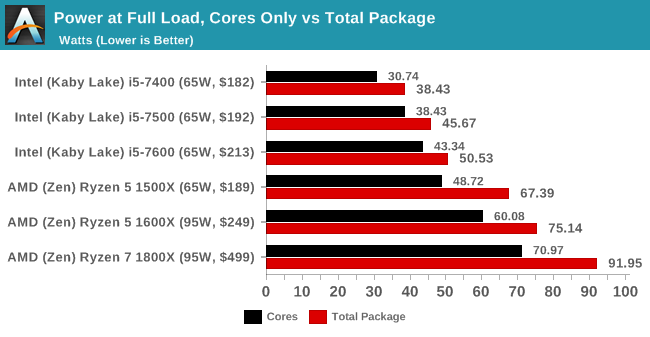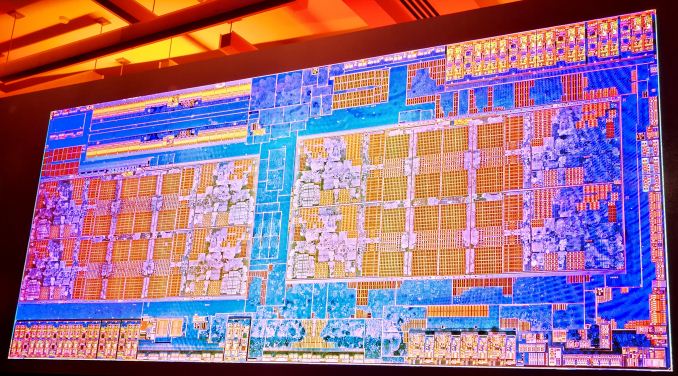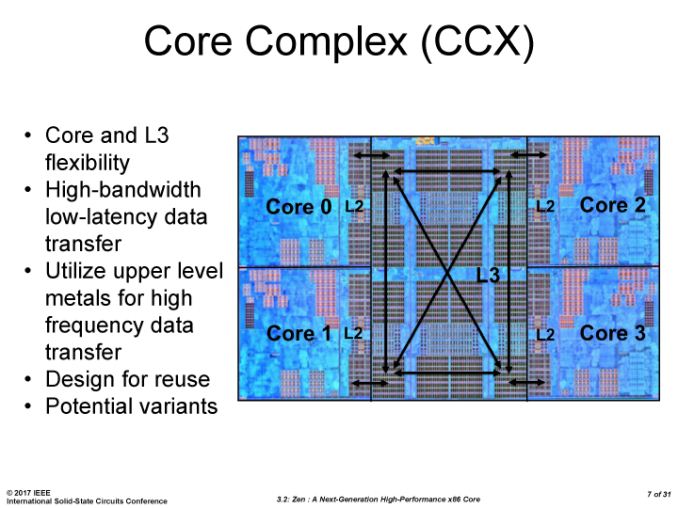The AMD Ryzen 5 1600X vs Core i5 Review: Twelve Threads vs Four at $250
by Ian Cutress on April 11, 2017 9:00 AM ESTRyzen 5, Core Allocation, and Power
In our original review of Ryzen 7, we showed that the underlying silicon design of the Ryzen package consists of a single eight-core Zeppelin die with Zen microarchitecture cores.
The silicon design consists of two core complexes (CCX) of four cores apiece. Each CCX comes with 512 KB of L2 cache per core, which is disabled when a core is disabled, and each CCX has 8MB of L3 cache which can remain enabled even when cores are disabled. This L3 cache is an exclusive victim cache, meaning that it only accepts evicted L2 cache entries, rather than loading data straight into it (which is how Intel builds their current L3 cache designs).
One of the suggestions regarding Ryzen 7’s performance was about thread migration and scheduling on the core design, especially as core-to-core latency varies depending on where the cores are located (and there’s a jump between CCXes). Despite the use of AMD’s new Infinity Fabric, which is ultimately a superset of HyperTransport, there is still a slightly longer delay jumping over that CCX boundary, although the default Windows scheduler knows how to manage that boundary as demonstrated by Allyn at PCPerspective.
So when dealing with a four-core or six-core CPU, and the base core design has eight-cores, how does AMD cut them up? It is possible for AMD to offer a 4+0, 3+1 or 2+2 design for its quad-core parts, or 4+2 and 3+3 variants for its hexacore parts, similar to the way that Intel cuts up its integrated graphics for GT1 variants.
There are some positives and negatives to each configuration, some of which we have managed to view through this review. The main downside from high level to a configuration split across CCXes, such as a 2+2 or 3+3, is that CCX boundary. Given that the Windows scheduler knows how to deal with this means this is less of an issue, but it is still present.
There are a couple of upsides. Firstly is related to binning – if the 2+2 chips didn’t exist, and AMD only supported 4+0 configurations, then if the binning of such processors was down to silicon defects, fewer silicon dies would be able to be used, as one CCX would have to be perfect. Depending on yield this may or may not be an issue to begin with, but having a 2+2 (and AMD states that all 2+2 configs will be performance equivalent) means more silicon available, driving down cost by having more viable CPUs per wafer out of the fabs.
Secondly, there’s the power argument. Logic inside a processor expends energy, and more energy when using a higher voltage/frequency. When placing lots of high-energy logic next to each other, the behavior becomes erratic and the logic has to reduce in voltage/frequency to remain stable. This is why AVX/AVX2 from Intel causes those cores to run at a lower frequency compared to the rest of the core. A similar thing can occur within a CCX: if all four cores of a CCX are loaded (and going by Windows Scheduler that is what happens in order), then the power available to each core has to be reduced to remain stable. Ideally, if there’s no cross communication between threads, you want the computation to be in opposite cores as threads increase. This is not a new concept – some core designs intentionally put in ‘dark silicon’ - silicon of no use apart from providing extra space/area between high power consuming logic. By placing the cores in a 2+2 and 3+3 design for Ryzen 5, this allows the cores to run at a higher power than if they were in 4+0 and 4+2 configurations.
Here’s some power numbers to show this. First, let’s start with a core diagram.
Where exactly the 0/1/2/3 cores are labelled is not really important, except 0-3 are in one CCX and 4-7 are in another CCX. As we load up the cores with two threads each, we can see the power allocation change between them. It is worth noting that the Ryzen cores have a realistic voltage/frequency limit near 4.0-4.1 GHz due to the manufacturing process – getting near or above this frequency requires a lot of voltage, which translates into power.
First up is the 1800X, which is a 4+4 configuration with a maximum TDP of 95W. One fully loaded core gets 22.6W, and represents the core at its maximum frequency with XFR also enabled. The same thing happens with two cores fully loaded, but at 20.6 W apiece. Moving onto three cores loaded is where XFR is disabled, and we see the drop to 3.7 GHz is saving power, as we only consume +1.33W compared to the two cores loaded situation. Three to four cores, still all on the same CCX, shows a decrease in power per core.
As we load up the first core of the second CCX, we see an interesting change. The core on CCX-2 has a bigger power allocation than any core in CCX-1. This can be interpreted in two ways: there is more dark silicon around, leading to a higher potential for this core on CCX-2, or that more power is required given the core is on its own. Technically it is still running at the same frequency as the cores on CCX1. Now as we populate the cores on CCX-2, they still consume more power per core until we hit the situation where all cores are loaded and the system is more or less equal.
Moving to the Ryzen 5 1600X, which is a 3+3 configuration, nets more of the same. During XFR with one or two cores loaded, the power consumption is high. As we move onto the second CCX, the cores on CCX-2 consumer more power per core than those already loaded on CCX-1.
It is worth noting here that the jump from two cores loaded to three cores loaded on the 3+3 gives a drop in the total power consumption of the cores. Checking my raw data numbers, and this also translates to a total package power drop as well, showing how much extra effort it is to run these cores near 4.0 GHz with XFR enabled.
On the Ryzen 5 1500X, using a 2+2 configuration, the situation is again duplicated. The hard comparison here is the 2+2 of the 1500X to the 4+0 on the 1800X, because the TDP of each of the processors is different.
It should be noted however the total package power consumption (cores plus IO plus memory controller and so on) is actually another 10W or so above these numbers per chip.

The cache configurations play an important role in the power consumption numbers as well. In a 3+3 or a 2+2 configuration, despite one or two cores per CCX being disabled, the L3 cache is still fully enabled in these processors. As a result, cutting 25% of the cores doesn’t cut 25% of the total core power, depending on how the L3 cache is being used.
Nonetheless, the Ryzen 5 1600X, despite being at the same rated TDP as the Ryzen 7 1800X, does not get close to matching the power consumption. This ropes back into the point at the top of the page – usually we see fewer cores giving a higher frequency to match the power consumption with parts that have more cores. Because the silicon design has such a high barrier to get over 4.0 GHz with voltage and power, AMD has decided that it is too big a jump to remain stable, but still given the 1600X the higher TDP rating anyway. This may be a nod to the fact that it will cause users to go out and buy bigger cooling solutions, providing sufficient headroom for Turbo modes and XFR, giving better performance.
Despite this, we see the 1800X and 1500X each tear their TDP rating for power consumption (92W vs 95W and 67W vs 65W respectively).
However, enough talking about the power consumption. Time for benchmarks!
















254 Comments
View All Comments
Meteor2 - Wednesday, April 12, 2017 - link
You're quite right. The R7 was a bit 'meh'. It loses a bit too much against the much-higher-clocked i7s. The R5, however, really stands out with better 99th percentile performance and better potential for more to come. (Contary to popular belief, i5s are clocked slower, not faster, than i7s.)Cooe - Monday, March 1, 2021 - link
And yet it was YOU screaming from the roof tops before it came out about just how shit it was going to be... -_-mat9v - Tuesday, April 11, 2017 - link
But then those old games will happily run over 200fps even on Ryzen. Would you care to comment?Can you actually feel the difference in how they work or you are just having a number orgasm?
Reflex - Tuesday, April 11, 2017 - link
Not really sure why I should care about how Ryzen performs in games that are several years old and that even budget CPU/GPU combinations can run more than adequately.cheshirster - Wednesday, April 12, 2017 - link
But Civilisation supports DX12 and it is here in tests with clear win of Zen.MisterJitter - Thursday, April 13, 2017 - link
Now as a precursor I am speculating here, but do you truly believe higher single core frequencies will continue to be the future of CPUs that are already pushing the limits. For example, do you believe Intel's next high end gaming CPU is going to be 6-7GHz? I don't think so... Technology used to increase exponentionally until now. I truly believe that if gaming performance is going to increase at the rate that it has over the past 10 years it's going to be because Devs finally star coding for multiple threads instead of relying on ONE workhorse.FriendlyUser - Tuesday, April 11, 2017 - link
Best CPU ever.eldakka - Thursday, April 13, 2017 - link
IMHO, that crown still belongs to the Celeron 300A. 50% overclockable (450MHz) was standard, and with the right riser card you could enable it for dual-socket systems.In today's terms, it'd be like buying two G4560's (3.5GHz, 2 cores, 4 threads, $63RRP e.a.), overclocking them by 50% on air-cooling (no fancy water) to 5.2GHz, and sticking them in a dual socket motherboard. Giving 4C/8T threads at 5.2GHz for ~$130, compared to an i7-7700K 4C/8T 4.2GHz for ~$340.
jrs77 - Tuesday, April 11, 2017 - link
Singlethreaded the i5 still beats the R5 and the i5 comes with an iGPU which is pretty much mandatory for office PCs and small workstations.Sorry to say, but the AMD R5 is pretty much useless for the majority of users, as the most used software is still singlethreaded (Office, Photoshop, etc).
Let's wait and see what the new AMD APUs will have to offer.
stockolicious - Tuesday, April 11, 2017 - link
"Let's wait and see what the new AMD APUs will have to offer."Its the CPU Ryzen replaces Bulldozer connected to a great iGPU - this is where Intel is going to have a rough time as they don't do top of shelf graphics. When released hard to believe AMD wont have by far the best APU they have made and maybe the best on the market. This might even get them some high end design wins that "Eluded" them during the bulldozer times.